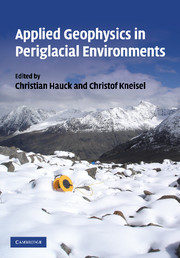Book contents
- Frontmatter
- Contents
- List of contributors
- Introduction
- Part I Geophysical methods
- Part II Case studies
- 5 Typology of vertical electrical soundings for permafrost/ground ice investigation in the forefields of small alpine glaciers
- 6 ERT imaging for frozen ground detection
- 7 Electrical resistivity values of frozen soil from VES and TEM field observations and laboratory experiments
- 8 Results of geophysical surveys on Kasprowy Wierch, the Tatra Mountains, Poland
- 9 Reassessment of DC resistivity in rock glaciers by comparing with P-wave velocity: a case study in the Swiss Alps
- 10 Quantifying the ice content in low-altitude scree slopes using geophysical methods
- 11 The use of GPR in determining talus thickness and talus structure
- 12 GPR soundings of rock glaciers on Svalbard
- 13 Arctic glaciers and ground-penetrating radar. Case study: Stagnation Glacier, Bylot Island, Canada
- 14 Mapping of subglacial topography using GPR for determining subglacial hydraulic conditions
- 15 Snow measurements using GPR: example from Amundsenisen, Svalbard
- 16 Mapping frazil ice conditions in rivers using ground penetrating radar
- Appendix: Tables of geophysical parameters for periglacial environments
- Index
- Plate section
- References
16 - Mapping frazil ice conditions in rivers using ground penetrating radar
Published online by Cambridge University Press: 22 August 2009
- Frontmatter
- Contents
- List of contributors
- Introduction
- Part I Geophysical methods
- Part II Case studies
- 5 Typology of vertical electrical soundings for permafrost/ground ice investigation in the forefields of small alpine glaciers
- 6 ERT imaging for frozen ground detection
- 7 Electrical resistivity values of frozen soil from VES and TEM field observations and laboratory experiments
- 8 Results of geophysical surveys on Kasprowy Wierch, the Tatra Mountains, Poland
- 9 Reassessment of DC resistivity in rock glaciers by comparing with P-wave velocity: a case study in the Swiss Alps
- 10 Quantifying the ice content in low-altitude scree slopes using geophysical methods
- 11 The use of GPR in determining talus thickness and talus structure
- 12 GPR soundings of rock glaciers on Svalbard
- 13 Arctic glaciers and ground-penetrating radar. Case study: Stagnation Glacier, Bylot Island, Canada
- 14 Mapping of subglacial topography using GPR for determining subglacial hydraulic conditions
- 15 Snow measurements using GPR: example from Amundsenisen, Svalbard
- 16 Mapping frazil ice conditions in rivers using ground penetrating radar
- Appendix: Tables of geophysical parameters for periglacial environments
- Index
- Plate section
- References
Summary
Introduction
In many high-latitude rivers, frazil ice production along open reaches sometimes causes blocking of the river course further downstream, beneath the seasonal ice cover, and may eventually lead to flooding and formation of extensive icing on the flood plain (Asvall 1998). When mitigation measures must be taken, rapid mapping of the ice conditions beneath the surface ice is advantageous. Therefore, the Norwegian Water Resources and Energy Directorate have tested the use of ground-penetrating radar (GPR) for this purpose.
The dielectric contrasts between ice and both water and wet sediments are large and clear reflections are expected (Table 16.1). Beneath the surface ice cover, a mixture of water and a variable amount of ice crystals (frazil ice) may be found. It is likely that this mixture of ice and water will cause clutter (chaotic returns from material inhomogeneity) and influence the velocity of a passing electromagnetic signal.
Airborne radar technology has been successfully applied to measure ice thickness on rivers and lakes (e.g. Arcone and Delaney 1987, Arcone 1991, Leconte and Klassen 1991, Arcone et al. 1997), and ground-based surveys of ice thickness have for instance been standardised by Sensors & Software Inc. through designated ‘ice picker’ software for use with their Noggin 500 MHz system. Other aspects of river ice, such as frazil ice and bottom ice, have received less attention, although there is a study by Dean (1977) and detection of frazil ice by airborne radar is also mentioned by Steven Arcone on the CRREL website (www.crrel.usace.army.mil/sid/gpr/Airborne_GPR.html).
- Type
- Chapter
- Information
- Applied Geophysics in Periglacial Environments , pp. 217 - 224Publisher: Cambridge University PressPrint publication year: 2008



